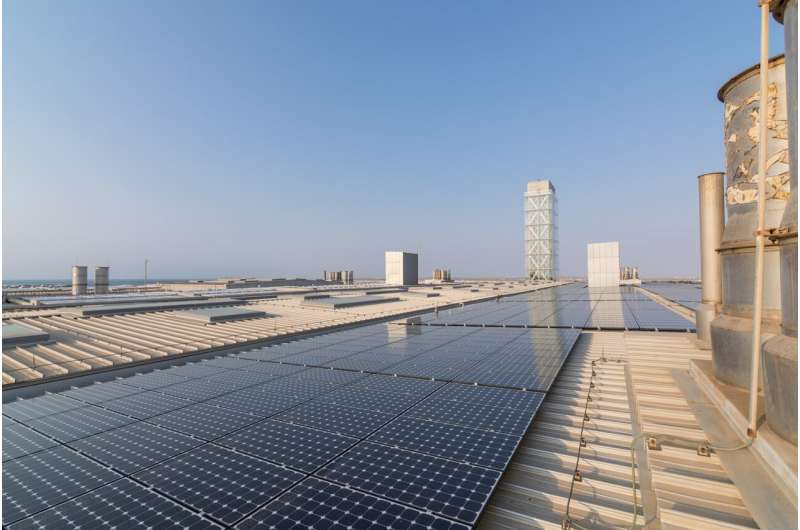
Weather variability and extreme events affect the optimal design and operation of renewable energy systems, particularly for striking a trade off between life cycle cost and carbon dioxide emissions.
A study of the impact of weather variability on the design and operation of renewable energy systems for office buildings in Saudi Arabia examines the tradeoff between the conflicting objectives of reducing both lifecycle cost and CO2 emissions. The research is published in the Journal of Building Engineering.
The integration of renewable energy systems is essential for future low-carbon electricity supply, but their design and operation must consider how weather variability affects the availability of renewable energy resources and energy demand.
Researchers from KAUST and the University of Sharjah have investigated a typical office building in three Saudi cities: Riyadh, Jeddah and NEOM, with electricity supplied by renewable energy and with flexibility to access the power grid. They also considered a case with no grid connection.
The researchers used weather datasets with different levels of variability to optimize the design of renewable energy systems for the buildings and assess their operational performance. They investigated the number of PV panels, wind turbines, batteries and power obtained from the grid to strike a trade-off between lifecycle cost and CO2 emissions.
Postdoc Farah Souayfane says the study shows that access to the power grid is important: the impact of weather variability and extreme weather events on the design of renewable energy systems can be diminished if there is access to a power grid.
“Accounting for full weather variability, particularly extreme weather events, increases the costs of a fully renewable energy system due to increased battery storage,” says Souayfane.
“However, if extreme weather events are not considered at the design stage then there can be a significant performance gap. This can be compensated by grid integration, which does not add to the system cost but adds to overall CO2 emissions,” she says.
The analysis shows that as CO2 emissions decrease, lifecycle costs increase. At one extreme is a system with maximum CO2 emissions and the lowest lifecycle cost, i.e., a system that has minimum renewable energy supply or is fully reliant on the power grid. At the other extreme is a solution with zero CO2 and maximum lifecycle cost, based on a fully renewable energy system without grid power.
Co-author Ricardo Lima says the impact of weather variability on the lifecycle cost of fully renewable energy systems can be reduced if a budget of CO2 emissions is provided.
“Given a cap of 50t CO2 emissions over 21 years, for example, the difference between lifecycle cost for the different weather datasets is small compared to the much higher cost for a fully renewable energy system in all three cities,” he says.
The researchers investigated the impact of a carbon tax and found that for the buildings and locations studied, the tax would need to be relatively high to incentivize fully renewable energy systems with zero CO2 emissions.
In the three locations, the highest demand for electricity occurs during summer due to the extensive use of air conditioning. In Jeddah, cooling is needed most of the year, while in Riyadh and NEOM, heating is often required on cold days.
Another observation is that extreme weather events occurred in December and January, corresponding to cloudy days and high energy demand, rather than periods with peak energy demand during summer months. The results indicate that the periods with lower solar irradiation determine what PV capacity to install.
The authors say that general findings from the study are relevant globally—for example energy systems with a grid connection are less sensitive to weather extremes—while in fully renewable energy systems, design and operation is highly impacted by weather variability.
Group leader Omar Knio says another avenue is to investigate the impact of climate change and extreme events on the design and operation of energy systems. “In particular, to account for climate change in terms of trends and variability, future work could investigate the likelihood of disruptions in renewable energy supply and exploration of countermeasures to mitigate potentially emerging negative impacts under different scenarios,” he says.
Saudi Arabia has one of the world’s highest rates per capita of energy consumption and CO2 emissions, with electricity demand growing at a significant rate due to increased economic development.
A Vision 2030 target of 30% renewables by 2030 could help the Kingdom fulfill its commitment to generate 50% of electricity from renewables and natural gas, while also helping to reduce its carbon emissions by 130 million tons by 2030.
More information:
Farah Souayfane et al, On the behavior of renewable energy systems in buildings of three Saudi cities: Winter variabilities and extremes are critical, Journal of Building Engineering (2023). DOI: 10.1016/j.jobe.2023.106408
Citation:
Balancing renewable energy systems in Saudi buildings (2023, June 12)
retrieved 12 June 2023
from https://techxplore.com/news/2023-06-renewable-energy-saudi.html
This document is subject to copyright. Apart from any fair dealing for the purpose of private study or research, no
part may be reproduced without the written permission. The content is provided for information purposes only.
Stay connected with us on social media platform for instant update click here to join our Twitter, & Facebook
We are now on Telegram. Click here to join our channel (@TechiUpdate) and stay updated with the latest Technology headlines.
For all the latest Technology News Click Here
For the latest news and updates, follow us on Google News.
